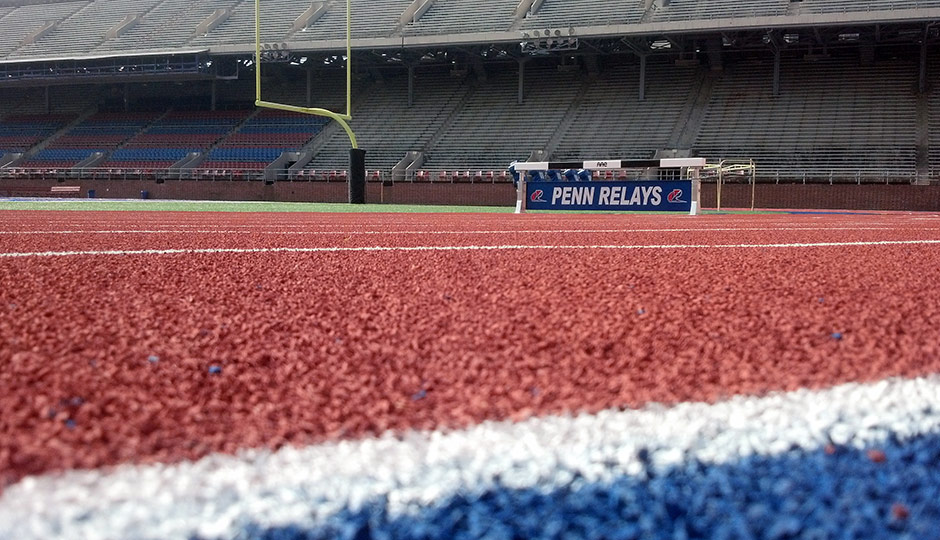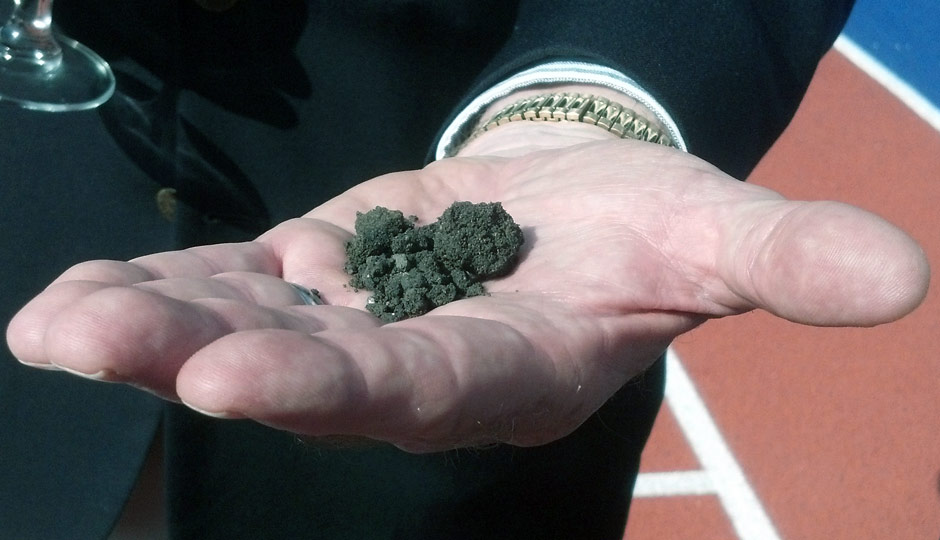Franklin Field Has a New Track — And You Can Run On It

Photo | Dan McQuade
Penn athletics officials were curious to see what would happen when workers dug up the old track. What would be below?
It turns out there was quite a bit of history there.
“What was beneath it were the original cinders from this track back in 1895,” said C.K. Buddington, director of the Friends of the Penn Relays. “The cinders that Jesse Owens, Paavo Nurmi — and some of our great friends who are members of the Wall of Fame on the far turn (Charlie Jenkins, Ron Delany from Villanova, Josh Culbreath from Oregon State) — ran on. All these people ran on these cinders. They built the legacy of this event.”
The cinders are gone. And the previous rubberized track is gone. Franklin Field has been hosting meets since the 1800s, and it now has its fastest running surface ever. Penn athletics officials unveiled the new track surface today, about seven years after the project was first studied. The track is now re-open to community members who wish to run on it.

G.K. Buddington, director of Friends of the Penn Relays, holds the cinders that were found during reconstruction of the track at Franklin Field. (Photo: Dan McQuade)
The track is a complete overhaul of the old surface. For you trackheads, there are some major changes to the set-up. Franklin Field has an oddly-configured track — some of its lanes are shorter than 400 meters. Before, lane 5 was the “400 meter” lane (the distance that lane 1 would be on most tracks). The new track moves the steeplechase pit from turn 4 to turn 1, which allows lane 4 to be the “400 meter” lane. Only three of the nine lanes are shorter than 400 meters now, instead of the previous four.
The move of the steeplechase pit also allows for some additional features. Sprints and hurdles can now be held either way on both stretches of the track, allowing meet organizers to run sprints in the optimal direction during windy conditions. The long/triple jump runways are longer, and pole vault has been moved to the 50 yard line of the football field.
And, the track is now surrounded by a sea of blue. A red track with blue accents: What better surface colors for the University of Pennsylvania!
The new track is made by Advanced Polymer Technology and is called ReKortan. This is one of the fastest track surfaces there is; it’s springy and fun to run on. Penn Relays director Dave Johnson says he’s excited to see the times runners can put down at April’s annual Penn Relays.
“Anytime we put down a new surface here,” Johnson says. “Everybody’s going to be faster.”
The surface was laid down by ATT Sports, a Moorestown, N.J., company run by Tony Cunningham. Marino Corporation, based in Schwenksville, provided construction management. The plaza next to the track, previously used for storage, has also been re-done: There won’t be any more puddles there. The renovation cost $3 million; a large chunk of that was donated by Penn track alum Elliott Rodgers and his wife.
Penn said today it was considering bidding for an IAAF Diamond League meet, the highest series of athletics competition in the world.
The track was designed by John Amato of JJA Sports, a Massachusetts company. Amato said he first started working with Penn in 2002, when he was called in when Penn planned to replace the football field’s artificial turf. He says it was a complicated process to get the track designed, produced and installed, but he’s thrilled at the results.
“What you see here is a miracle,” Amato says. “And I don’t use that word lightly.”
The reconstructed track is generally open to the public 11 a.m. to 2 p.m. on weekdays.
Like what you’re reading? Stay in touch with Be Well Philly — here’s how:
- Like Be Well Philly on Facebook
- Follow Be Well Philly on Twitter
- Follow Be Well Philly on Pinterest
- Get the Be Well Philly Newsletter


